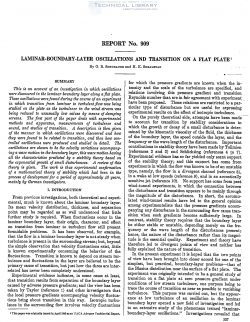naca-report-909

- Version
- 171 Downloads
- 3.33 MB File Size
- 1 File Count
- August 31, 2016 Create Date
- August 31, 2016 Last Updated
National Advisory Committee for Aeronautics, Report - Laminar Boundary Layer Oscillations and Transition on a Flat Plate

This is an account of an ineestigation in which oscillations
were discovered in. the laminar boundary layer along aflat plate.
These oscillations were found during the course of an experiment
in which transition from laminar to turbulent flow was being
studied on the plate as the turbulence in the wind stream was
being reduced to unusually low values by means of damping
screens. The first part of the paper deals with experimental
methods and apparatus, measurements of turbulence and
sound, and studies of transition. A description is then given
of the manner in which oscillations were discorered and how
they were found to be related to transition, and then how con-
trolled oscillations were produced and studied in detail. The
oscillations are shown to be the velocity eariations accompany-
ing a wave motion in the boundary layer, this ware motion having
all the characteristics predicted by a stability theory based on
the exponential growth of small disturbances. A review of this
theory is git-en. The work is thus erperimental confirmation
of a mathematical theory of stability which had been in the
process of development for a pen’od of approximately 40 years,
mainly by German investigators.
From previous investigations, both theoretical and experi-
mental, much is known about the laminar boundary layer.
Its mean velocity distribution, thickness, and separation
point may be regarded as so well understood that little
further study is required. When fluctuations occur in the
laminar boundary layer, their origin, character, and effect
on transition from laminar to turbulent flow still present
formidable problems. It has been observed, for example,
that the flow in a laminar boundary layer is not steady when
turbulence is present in the surrounding stream; but, beyond
the simple observation that velocity fluctuations exist, little
is known experimentally concerning the behavior of the
fluctuations. Transition is known to depend on stream tur-
bulence and fluctuations in the layer are believed to be the
primary cause of transition, but just how the three are inter-
related has never been completely understood.
| File | Action |
|---|---|
| naca-report-909 Laminar Boundary Layer Oscillations and Transition on a Flat Plate.pdf | Download |

Comment On This Post